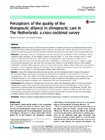Perceptions of the quality of the therapeutic alliance in chiropractic care in The Netherlands: a cross-sectional survey

Abstract
Background:
Research in various medical fields demonstrates a consistent and positive association between clinical outcomes and the quality of the therapeutic alliance between the patient and clinician. The aim of this study was to explore how well chiropractors and their patients in The Netherlands perceive the quality of their working relationship.
Methods:
A nationwide survey of chiropractors and their patients was conducted in The Netherlands, using a validated Dutch translation of the Working Alliance Inventory (WAV-12). Data were collected over a 5-week period in September-October 2014. Both patients and chiropractors were requested to reflect on 12 statements about to how well they perceived their collaboration in reaching consensus on treatment goals and treatment strategies, and how well they perceived the existence of an affective bond in their working relationship. A 5-point Likert scale was used to answer each question. Higher ratings reflected a more positive perception of the therapeutic alliance. Furthermore, levels of agreement between patients’ and chiropractors’ perceptions of the quality of their therapeutic alliance were determined.
Results:
In total, 207 working relationships between patients and their chiropractor were analysed. The quality of the therapeutic alliance was perceived as being very positive for both patients (n = 183, mean 49.14 ± 7.12) and chiropractors (n = 202, mean 50.48 ± 4.97). There was no difference in patients’ perceptions whether treated by a male or female chiropractor, nor in relation to the chiropractor’s years of experience. Nevertheless, poor agreement was found between perceptions of patients and chiropractors in the same relationship (ICC = 0.13).
Conclusions:
Both patients and chiropractors perceived the quality of the therapeutic alliance as being very positive. Despite these positive results, patient and chiropractor pairs perceived the level of collaboration in order to reach agreement on treatment goals and strategies and the quality of their affective bond very differently. Clinically, these results suggest that chiropractors should, during the course of treatment, continue to collaborate with their patient and frequently verify whether their patient continues to agree with the treatment goals and treatment plan applied to further develop, improve and maintain a positive therapeutic alliance.
Collections
Date
2016Author
Lambers, Nicoline
Bolton, Jennifer